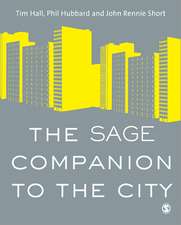Ethnography for Designers
Autor Galen Cranzen Limba Engleză Paperback – 25 feb 2016
| Toate formatele și edițiile | Preț | Express |
|---|---|---|
| Paperback (1) | 249.73 lei 6-8 săpt. | |
| Taylor & Francis – 25 feb 2016 | 249.73 lei 6-8 săpt. | |
| Hardback (1) | 1021.67 lei 6-8 săpt. | |
| Taylor & Francis – mar 2016 | 1021.67 lei 6-8 săpt. |
Preț: 249.73 lei
Preț vechi: 297.56 lei
-16% Nou
Puncte Express: 375
Preț estimativ în valută:
47.78€ • 50.03$ • 39.54£
47.78€ • 50.03$ • 39.54£
Carte tipărită la comandă
Livrare economică 05-19 aprilie
Preluare comenzi: 021 569.72.76
Specificații
ISBN-13: 9781138121096
ISBN-10: 1138121096
Pagini: 286
Ilustrații: 54
Dimensiuni: 174 x 246 x 20 mm
Greutate: 0.57 kg
Ediția:1
Editura: Taylor & Francis
Colecția Routledge
Locul publicării:Oxford, United Kingdom
ISBN-10: 1138121096
Pagini: 286
Ilustrații: 54
Dimensiuni: 174 x 246 x 20 mm
Greutate: 0.57 kg
Ediția:1
Editura: Taylor & Francis
Colecția Routledge
Locul publicării:Oxford, United Kingdom
Public țintă
Postgraduate, Professional, and UndergraduateCuprins
Preface Part 1: The Ethnographic Design Project 1. Introduction to Design Ethnography 2. The Ethnographic Design Project: A Step-by-Step Overview 3. Sited Micro-cultures 4. Cultural Informants 5. Finding Meaning in Taxonomies 6. Literature Review: What Do Others Say? 7. Translating into Physical Design Glossary of Key Terms Bibliography Part 2: Report-Writing and Sample Reports Section 1. Preparing a Final Report Section 2. The Design Board Section 3. Sample Ethnographic Reports
Notă biografică
Galen Cranz is Professor of Architecture at the University of California at Berkeley, a Ph.D. sociologist from the University of Chicago, and a certified teacher of the Alexander Technique. She teaches social and cultural approaches to architecture and urban design. Emphasizing ethnography as a research method, she brings users' as well as creators' perspectives to our understanding of built environments.
Recenzii
"Cranz draws upon three decades of teaching semantic ethnography in this thoughtful guide to doing research for design. The ethnographic approach is uniquely suited to sensitive and nuanced study of spaces of micro-cultures. Designers will find it an effective tool in envisioning places that are supportive of local cultures." - Amita Sinha, Professor of Landscape Architecture, University of Illinois at Urbana Champaign, USA
"The outcome of design activity typically implies the involvement of an audience. This much-needed text arms the designer with the cultural awareness and specific skills needed to approach projects in a refreshingly unbiased way. Noted sociologist Professor Galen Cranz who, for many years, has been deeply engaged with the education of designers, clarifies the ethnographic process and particularizes it for design. Ethnography for Designers provides designers with what they need to know about their audience and users as they inhabit the various research phases of any project." - Leslie Becker, Ph.D. Professor, Graphic Design and Visual Studies, California College of the Arts, San Francisco, California, USA
"In Ethnography for Designers architects and architecture students will find an invaluable guide to conducting research projects that reveal culturally significant aspects of the built environment and that generate thoughtful design proposals. With an abundance of clear directives and excellent exemplars, Professor Cranz demonstrates how architects can be researchers and designers. As many become increasingly entranced with collecting large amounts of data, nearly mechanically with digital tools, the careful attention Cranz pays to listening and learning, to analyzing and imagining, is particularly welcome." - Karen A. Franck, Professor, New Jersey Institute of Technology and co-author of Design Through Dialogue and Architecture from the Inside Out
"Ethnography for Designers is a tour de force away from common notions of science focused on deterministic hypothesis testing. Discovery science, so important to physical and biological sciences, is a welcome paradigm shift in the social sciences. Ethno-semantic methods empower creative architects to acquire cultural knowledge inspiring innovative new building forms to enhance their professional responsibility to users. This important book also thoughtfully acknowledges limitations of verbal interviews in accessing environmental meaning, suggesting a follow-up volume addressing the visual." - Eleftherios Pavlides Ph.D., AIA, Professor of Architecture, School of Architecture, Art and Historic Preservation, Roger Williams University, USA
"This volume fits a number of teaching niches, including courses in architectural programming, environmental psychology, social geography, and environment-behavior studies. Getting architecture and planning students more attuned to client and user needs is a crucial component of architectural and planning education. This book is a potent spur, helping students and professionals to better understand the central ways that environmental, social, and design factors contribute to human life and well-being. A unique strength of the volume is its thoughtfully conceived drawings and other illustrations." - David Seamon, Professor of Environment-Behavior and Place Studies, Department of Architecture, Kansas State University, USA
"Value this book not simply for the practical implications it contains in layering cultural anthropology technique over cycles of research, planning, and design, but for ways it pedagogically synthesizes listening and imagining the everyday built environment. Ethnography for Designers efficiently teaches both the practitioner and student how to question assumptions so often overlooked in the powerful nexus of meaning, space, and place." - Dr. Anthony Bernier, Professor, San Jose State University, USA
"Ethnography for Designers is a revelation, reaching beyond the scope of architecture. This book has applications for any artist whose practice considers site specificity, community involvement, collaboration, or other social intervention. In a sociopolitical climate that increasingly values art as a form of research, artists can use semantic ethnography as a theory and method to redefine the relationships of their artworks to audiences. Cranz offers a practical, useful, and timely guide for the use of semantic ethnography in contemporary practice." - Chelsea Rushton, MFA, University of Calgary, Canada
"Galen Cranz’s new book on ethnography is one every graduate student in architecture should read; and once begun will want to finish, as it is written in a very engaging way. Rather than being a dry text on how to do research, it is written as a guide to explore how and why people do what they do in relation to design. The text considers how to ask the good questions and how to get reliable answers at the same time as it reveals the important issues relating to ethnographic study. While fully addressing the complexities, intricacies and paradoxes of ethnographic work, Cranz makes such research accessible to the design student in a memorable and readable form." - Julia W. Robinson, PhD, FAIA, ACSA Distinguished Professor, Professor, School of Architecture, University of Minnesota, USA
"The outcome of design activity typically implies the involvement of an audience. This much-needed text arms the designer with the cultural awareness and specific skills needed to approach projects in a refreshingly unbiased way. Noted sociologist Professor Galen Cranz who, for many years, has been deeply engaged with the education of designers, clarifies the ethnographic process and particularizes it for design. Ethnography for Designers provides designers with what they need to know about their audience and users as they inhabit the various research phases of any project." - Leslie Becker, Ph.D. Professor, Graphic Design and Visual Studies, California College of the Arts, San Francisco, California, USA
"In Ethnography for Designers architects and architecture students will find an invaluable guide to conducting research projects that reveal culturally significant aspects of the built environment and that generate thoughtful design proposals. With an abundance of clear directives and excellent exemplars, Professor Cranz demonstrates how architects can be researchers and designers. As many become increasingly entranced with collecting large amounts of data, nearly mechanically with digital tools, the careful attention Cranz pays to listening and learning, to analyzing and imagining, is particularly welcome." - Karen A. Franck, Professor, New Jersey Institute of Technology and co-author of Design Through Dialogue and Architecture from the Inside Out
"Ethnography for Designers is a tour de force away from common notions of science focused on deterministic hypothesis testing. Discovery science, so important to physical and biological sciences, is a welcome paradigm shift in the social sciences. Ethno-semantic methods empower creative architects to acquire cultural knowledge inspiring innovative new building forms to enhance their professional responsibility to users. This important book also thoughtfully acknowledges limitations of verbal interviews in accessing environmental meaning, suggesting a follow-up volume addressing the visual." - Eleftherios Pavlides Ph.D., AIA, Professor of Architecture, School of Architecture, Art and Historic Preservation, Roger Williams University, USA
"This volume fits a number of teaching niches, including courses in architectural programming, environmental psychology, social geography, and environment-behavior studies. Getting architecture and planning students more attuned to client and user needs is a crucial component of architectural and planning education. This book is a potent spur, helping students and professionals to better understand the central ways that environmental, social, and design factors contribute to human life and well-being. A unique strength of the volume is its thoughtfully conceived drawings and other illustrations." - David Seamon, Professor of Environment-Behavior and Place Studies, Department of Architecture, Kansas State University, USA
"Value this book not simply for the practical implications it contains in layering cultural anthropology technique over cycles of research, planning, and design, but for ways it pedagogically synthesizes listening and imagining the everyday built environment. Ethnography for Designers efficiently teaches both the practitioner and student how to question assumptions so often overlooked in the powerful nexus of meaning, space, and place." - Dr. Anthony Bernier, Professor, San Jose State University, USA
"Ethnography for Designers is a revelation, reaching beyond the scope of architecture. This book has applications for any artist whose practice considers site specificity, community involvement, collaboration, or other social intervention. In a sociopolitical climate that increasingly values art as a form of research, artists can use semantic ethnography as a theory and method to redefine the relationships of their artworks to audiences. Cranz offers a practical, useful, and timely guide for the use of semantic ethnography in contemporary practice." - Chelsea Rushton, MFA, University of Calgary, Canada
"Galen Cranz’s new book on ethnography is one every graduate student in architecture should read; and once begun will want to finish, as it is written in a very engaging way. Rather than being a dry text on how to do research, it is written as a guide to explore how and why people do what they do in relation to design. The text considers how to ask the good questions and how to get reliable answers at the same time as it reveals the important issues relating to ethnographic study. While fully addressing the complexities, intricacies and paradoxes of ethnographic work, Cranz makes such research accessible to the design student in a memorable and readable form." - Julia W. Robinson, PhD, FAIA, ACSA Distinguished Professor, Professor, School of Architecture, University of Minnesota, USA
Descriere
This book is a practical guide for those teaching social factors and social research methods to designers and for those using these methods in practice.













